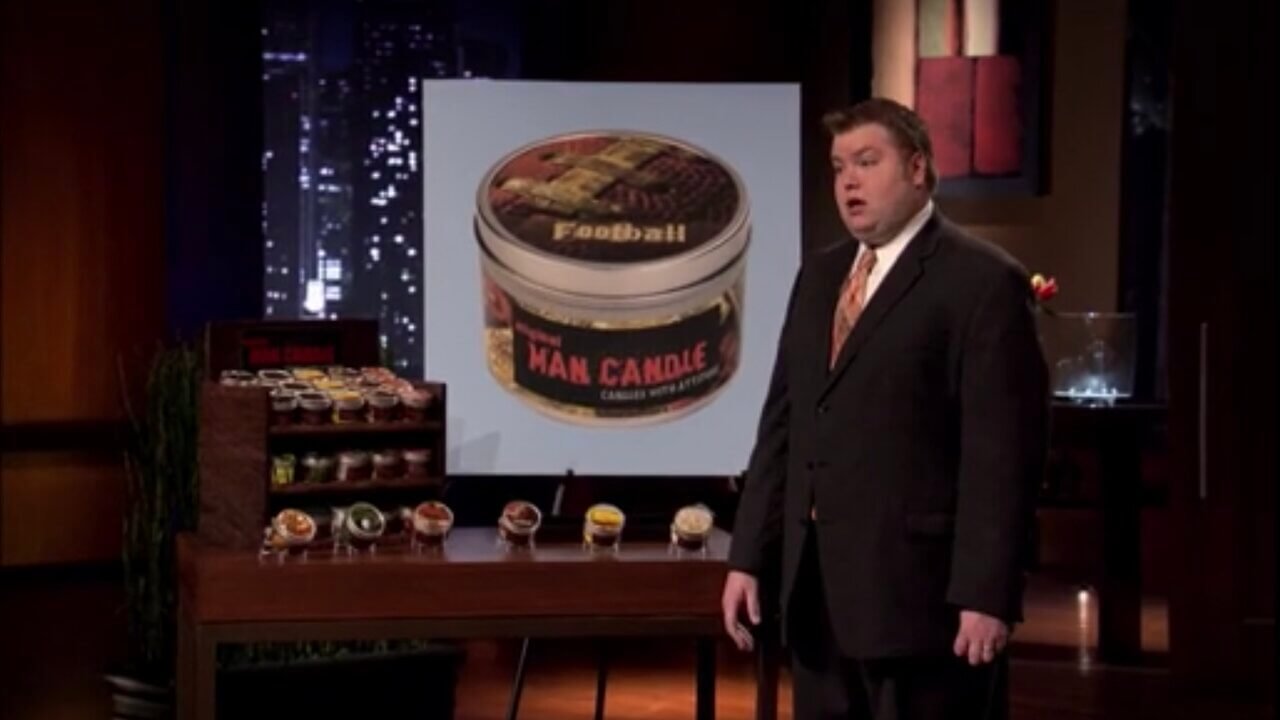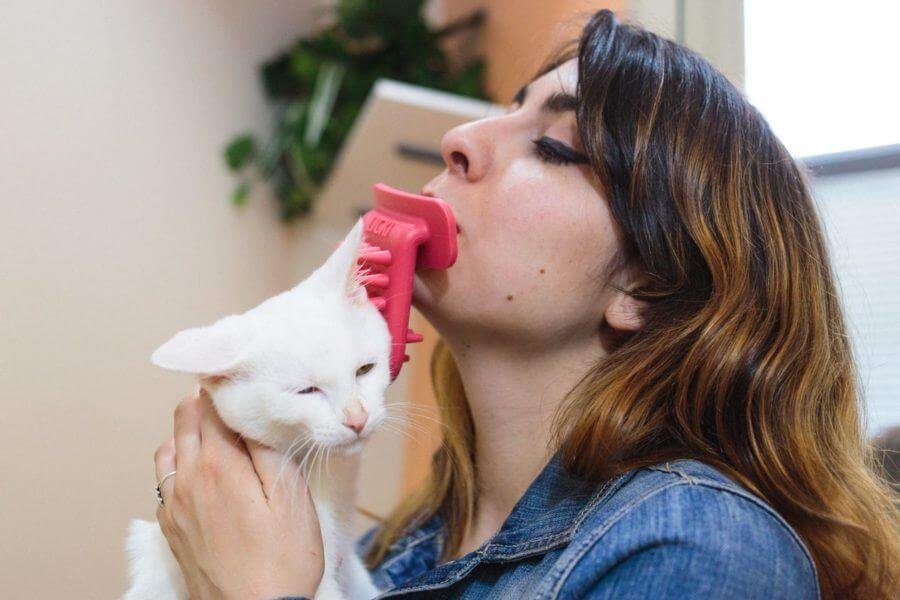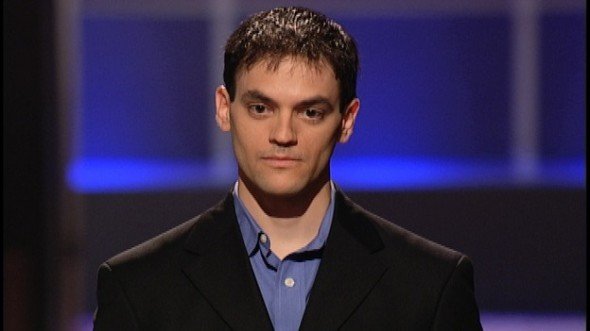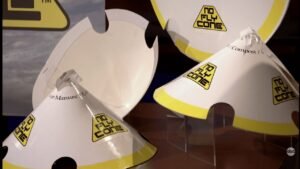So here’s the pitch: Not every Shark Tank idea is destined for millionaire glory. Some are pure novelty shots—the kind that gets a chuckle but makes the Sharks eye their checkbooks warily. The Original Man Candle fits that mold. If you like business breakdowns without the sugarcoat, let’s walk through what really happened.
Contents
ToggleWhat Was the Man Candle Play?
Man Candle was simple—candles for men, with masculine scents. Forget vanilla or lavender. Think New Car, Beach Babe, Football, or Campfire. The founder, Johnson Bailey, was a college kid with hustle, betting that guys wanted their own slice of the candle game.
He hand-poured each candle himself and hustled them into 400 stores before pitching on Shark Tank. Sound outlandish? Sure. But quirky products have scored big before. The difference: Man Candle didn’t quite crack the code. Let’s break down why.

Who Launched Man Candle and Why?
Johnson Bailey launched Man Candle with one thing in mind: nobody catered to men in the candle aisle. He noticed the market was flooded with pretty scents and wanted something geared to guys—something you wouldn’t be embarrassed to burn in your man cave.
Want a classic founder’s story? Bailey was a broke college student, bootstrapping every step. He poured candles in his spare time, cold-called stores, and thought the market gap was huge. Here’s the thing: Being different isn’t always enough. Execution, branding, and timing matter if you’re going to punch through the noise.
I’ve seen founders get so laser-focused on a niche that they don’t stop to ask if it can scale. Bailey tackled a real gap, but would the demand ever go mainstream? That doubt followed him onto Shark Tank.
How Did the Shark Tank Pitch Go Down?
Shark Tank, Season 2, Episode 8. Bailey stepped onto the carpet asking for $50,000 in exchange for 25% of Man Candle. He brought his energy and did what every founder should: handed out samples, told his story, and didn’t flinch under the lights.
He’d done $53,000 in sales the previous year, with products in 400 stores. That’s real work. I’ve seen many get on the show with less. Still, Shark Tank is as much about the WHY as the story.
Here’s how the Sharks reacted, straight and unpolished:
- Kevin O’Leary: He called it crap for tourists. Looked at Bailey and saw a product anyone could whip up. No patent, no unique recipe, just an idea too easy to copy.
- Barbara Corcoran: Said the business was too small and too risky for her checkbook. She’s seen these cute plays before; most evaporate fast.
- Daymond John: Didn’t pull punches: You lack cash, credit, and customers. No scale, no edge, plenty of novelty.
- Robert Herjavec: He couldn’t see the money. Great ideas flounder without profit, and Herjavec thought this was one of them.
- Mark Cuban: He admired Bailey’s passion, but said if there’s no moat, there’s no deal. Scented candles for men just didn’t seem defensible.
No Shark bit. Bailey left the Tank with nothing except exposure and a bruised ego. Don’t think that’s a death sentence—some companies use the show to slingshot ahead without the Sharks. Man Candle? Not quite.
Man Candle Net Worth: Where Did the Money Go?
Let’s talk numbers, because too many forget this is what counts after the cameras stop.
Bailey claimed $53,000 in sales for the year before his pitch—a respectable chunk for handmade goods. But let’s get real: that’s not enough to wow investors.
After Shark Tank, Man Candle did get interest. P. Nathan Thornberry ponied up $65,000 for 35% equity in a deal made after the show wrapped. This is the classic Shark Tank echo—attention often brings outside suitors. Bailey thought he’d finally found the runway to launch.
Today, you can check the Man Candle website. Everything is out of stock. No new scents, no announcements, just ghost-town vibes. If SharkWorth had to call it, the brand’s value is near zero in 2025. You can’t sell inventory you don’t have.
In the startup scene, cash is oxygen, and Man Candle ran out. Profit margins were razor-thin, marketing was weak, and with the founder pushed out, there was no spark left.
Post-Show Deals and Legal Wreckage
Here’s where things get messy, fast.
Bailey took Thornberry’s post-show investment, but the honeymoon didn’t last. The partnership soured—classic who runs the show now tension. In true business reality, it got litigious. Thornberry sued, won in court, and Bailey lost control of the company he started.
Legal battles kill momentum. Once the founder’s gone and lawyers have spent all the cash, usually there’s no product left to sell. Thornberry became the owner, but the Man Candle brand flatlined in his hands.
You see this story far more than you’d think. The entrepreneur loses the reins, and with it, the company’s soul. Man Candle’s brand was a novelty, held together by Bailey’s hustle. Without him, there was nothing left to sell.

What Happened to Man Candle After Shark Tank?
Post-lawsuit, the business limped along for a bit. The website hung around, products listed but unavailable. No shipping, no restock, just digital silence.
Some brands pivot and use the Shark Tank buzz to rebirth themselves months or years later. Not this time. The founder was out. The investor, likely burned, pulled the plug. By 2025, you won’t find Man Candle on shelves or online. If you want masculine-scented candles, buy from someone else or make your own.
The big picture? Novelty products rarely become legacy brands. Man Candle’s run was always going to be short unless it landed a monster viral moment or a retail giant as a partner.
What Did Man Candle Actually Sell?
Let’s get into specifics. What made Man Candle different wasn’t just the pitch—it was the scents. This was not your girlfriend’s pumpkin spice collection.
The top sellers were:
- New Car: Imagine the smell of fresh leather and dashboard—auto-shop as cologne.
- Beach Babe: Sand, sunscreen, and the nostalgia of teenage summer.
- Campfire, Football, Grandpa’s Pipe: Scents that scream man cave over bathroom vanity.
Every candle was hand-poured. This was low-volume, craft play, not a mass-market operation. The problem? Scent is subjective, and men weren’t running to replace their deodorant with wax. Once the novelty faded, so did sales traction.
I’ve seen Founders take clever branding and find lightning-in-a-bottle if the copy, packaging, and story hit hard. Man Candle flirted with that but never crossed the line.
Any Shot at a Comeback?
Let’s keep it simple. As of 2025, there’s zero evidence Man Candle is coming back. The website is a tombstone, social media dead, and the original founder has moved on.
Sometimes, brands stage a comeback if the right influencer or retailer picks up the torch. Here? There’s no signal, no big return, no hopeful tease.
If Bailey still holds the entrepreneurial itch, it’s aimed at something new. Bottom line: Don’t wait for Man Candle 2.0. If a revival ever comes, it’ll need fresh leadership and a much bigger market plan.
Conclusion: Lessons from the Man Candle Saga
There’s a favorite line in every pitch room: What’s to stop someone from copying this? If you’re a founder, you better have a tight answer. Man Candle never did.
Johnson Bailey’s journey shows the best and the rawest of the Shark Tank story. He had drive, scored real sales, braved the cameras. He even landed an investment when the Sharks passed.
But here’s the hard truth: Product quirks and niche branding don’t beat legal headaches, lack of a moat, or cash burn. The Sharks were right—no defensible edge, no mass-market hook. Novelty is fun, but investors—Shark or not—want sticky, scalable, defensible businesses.
If you’re building, ask yourself: Can someone else replicate your product overnight? If yes, you’re a sitting duck. Want to stay alive? Create a brand so sticky, or a margin so fat, that the copycats drown before they catch up.
Man Candle had the hustle. It just lacked the edge.
So, thinking you’ve got the next wild idea for the Tank? Respect the hustle, but plan for war, not just applause. The grind’s real, and the market is ruthless. If you’re serious, learn from stories like Man Candle—then outwork everyone else in the room.
FAQs: Street-Smart Answers for Curious Minds
Is Man Candle from Shark Tank still in business?
All signs point to no – zero inventory, no updates, no vibe. It’s dead.
Did any Shark invest in Man Candle?
Nope. The Sharks passed. Post-show money came from P. Nathan Thornberry, but it flopped.
How much did Man Candle sell on Shark Tank?
Bailey claimed $53,000 in sales the prior year. Hand-poured. Gritty, but not bankable.
Who owns Man Candle now?
Investor P. Nathan Thornberry took over via lawsuit. Bailey, the founder, is out of the picture.
Why did the Sharks reject Man Candle?
No moat, no scale, no edge. They saw novelty—fun, but easy to copy and tough to grow.
Was Man Candle profitable?
Not really. Margins were tight, sales too limited. Startups with these struggles rarely profit.
Where can I buy Man Candle products today?
You can’t. The website shows out of stock everywhere. Retail gone, inventory zero.
Any chance Man Candle will come back?
No signals, no comeback news. With the founder gone and inventory dead, it’s a long shot.
If you love the raw, no-fluff details, check out more stories like this at SharkWorth. Inside the pitch room and beyond, we break down what actually works—hype and flop.










